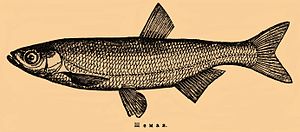Mairenke
| Mairenke | ||||||||||||
|---|---|---|---|---|---|---|---|---|---|---|---|---|

Mairenke ( Alburnus chalcoides ) |
||||||||||||
| Systematics | ||||||||||||
|
||||||||||||
| Scientific name | ||||||||||||
| Alburnus chalcoides | ||||||||||||
| ( Güldenstädt , 1772) |
The Danube bleak ( Alburnus chalcoides ) is a fish from the family of carp fish (Cyprinidae). It is counted among the white fish . It was described as Chalcalburnus chalcoides , but the taxon Chalcalburnus recently classified under the genus Alburnus .
features
The Mairenke reaches a length of 15 to 25 centimeters and has a high-backed body with a greenish top. The flanks and belly are silver-colored. The dorsal and caudal fin are slightly black, the others colorless. The number of scales along the sidelines is 60 to 67. The number of the fin rays is in the dorsal fin 9 to 11, in the anal fin 17 to 20, in the pectoral fin 16, in the ventral fin 10 to 11 and in the tail fin 19. A adipose fin does not exist, as the fish not to Renken heard as one might assume based on the German name.
distribution
There are anadromous subspecies in the tributaries of the Caspian Sea and the northern Black Sea . In the Danube, however , these only occur as far as Romania through the barrages .
There are populations of the subspecies Seelaube or Schiedling ( Alburnus chalcoides mento ) in the Alpine and pre-Alpine lakes that do not migrate or only migrate very briefly. For example, they are protected in the Mondsee - Attersee European protected area ( Natura 2000 ), which was specially created for this and the pearl fish , but recently it was no longer possible to detect them in Lake Traunsee . The Mairenke can be found south of the main Alpine ridge in the Wörthersee, where it migrates to the Reifnitzbach (also a protected body of water) to spawn from mid-April to early May.
Way of life
The anadromous Mairenken live in brackish water and migrate from autumn to the upper reaches of the rivers to spawn over sandy or gravel spots in spring. The stationary subspecies live in shoals in the deep and cold water of the lakes to spawn on sandy banks in the lake itself or in the tributaries . The spawning season falls here from May to June (name!). The Mairenken feed on plankton and mosquito larvae .
Importance in fishing
In Central Europe, the Mairenken are no longer valued as food fish because, like all white fish, they have many bones . The fish in south-east Europe are still fished today, just as they were in Central Europe in the past.
protection
The Mairenke is listed by the European Union in Annex II of the Habitats Directive and is therefore a type of community interest, for whose preservation special protected areas must be designated by the member states.
literature
- Wolfgang Hauer: Seelaube, Mairenke, Schiedling (Chalcalburnus chalcoides mento). In: Austria's fishery. Volume 50, 1997, p. 210 ( PDF on ZOBODAT ).
- Roland Gerstmeier, Thomas Romig: The freshwater fish of Europe , Kosmos-Verlag, Stuttgart 1998, ISBN 3-440-07068-9 .
Web links
- Mairenke on Fishbase.org (English)
- Alburnus chalcoides inthe IUCN 2013 Red List of Threatened Species . 2. Posted by: Freyhof, J. & Kottelat, M., 1998. Retrieved December 14, 2013.
Individual evidence
- ↑ see Chalcalburnus , English Wikipedia - there with further references
- ↑ Code designation 1141 Sea dove (Chalcalburnus chalcoides mento, Mairenke) of the animal species listed in Table 2 of Annex II of the Habitats Directive (§ 5 Z. 1)
- ↑ Mairenke or Schiedling , angeln-alex.de
- ^ European protected area Mondsee and Attersee (FFH area, AT3117000). In: Geographical Nature Conservation Information System (GENISYS), e-gov.ooe.gv.at. Retrieved May 15, 2020 . .
- ↑ Simonetta Siligato, Clemens Gumpinger: Europeschutzgebiet (Natura 2000) Mondsee - Attersee. Study to improve the living conditions of pearlfish and sea pigeon in the lake.
- ↑ Carinthian Institute for Lake Research: Seelaube , accessed on May 7, 2017.